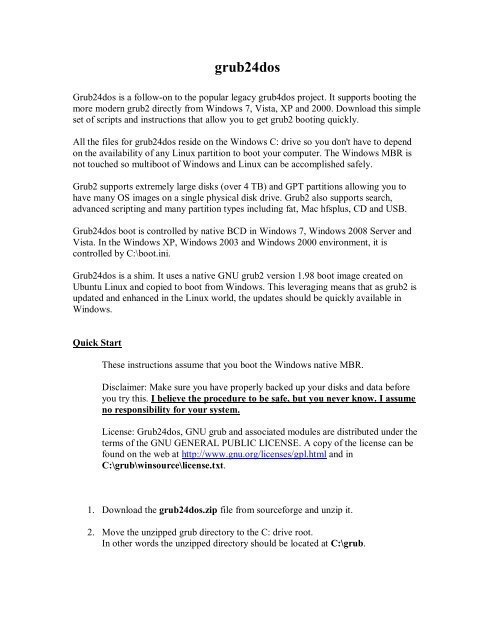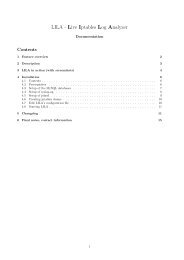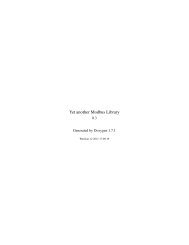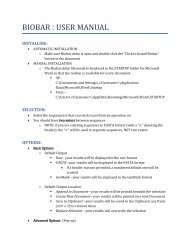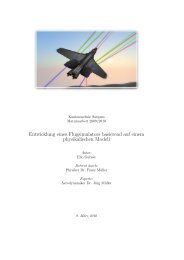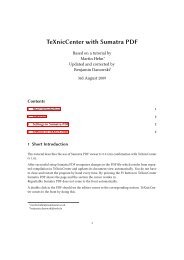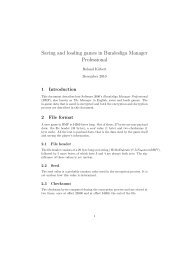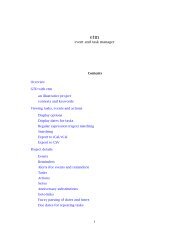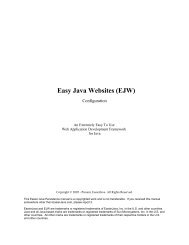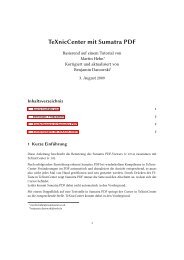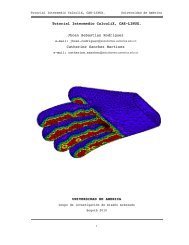grub24dos
grub24dos
grub24dos
You also want an ePaper? Increase the reach of your titles
YUMPU automatically turns print PDFs into web optimized ePapers that Google loves.
<strong>grub24dos</strong><br />
Grub24dos is a follow-on to the popular legacy grub4dos project. It supports booting the<br />
more modern grub2 directly from Windows 7, Vista, XP and 2000. Download this simple<br />
set of scripts and instructions that allow you to get grub2 booting quickly.<br />
All the files for <strong>grub24dos</strong> reside on the Windows C: drive so you don't have to depend<br />
on the availability of any Linux partition to boot your computer. The Windows MBR is<br />
not touched so multiboot of Windows and Linux can be accomplished safely.<br />
Grub2 supports extremely large disks (over 4 TB) and GPT partitions allowing you to<br />
have many OS images on a single physical disk drive. Grub2 also supports search,<br />
advanced scripting and many partition types including fat, Mac hfsplus, CD and USB.<br />
Grub24dos boot is controlled by native BCD in Windows 7, Windows 2008 Server and<br />
Vista. In the Windows XP, Windows 2003 and Windows 2000 environment, it is<br />
controlled by C:\boot.ini.<br />
Grub24dos is a shim. It uses a native GNU grub2 version 1.98 boot image created on<br />
Ubuntu Linux and copied to boot from Windows. This leveraging means that as grub2 is<br />
updated and enhanced in the Linux world, the updates should be quickly available in<br />
Windows.<br />
Quick Start<br />
These instructions assume that you boot the Windows native MBR.<br />
Disclaimer: Make sure you have properly backed up your disks and data before<br />
you try this. I believe the procedure to be safe, but you never know. I assume<br />
no responsibility for your system.<br />
License: Grub24dos, GNU grub and associated modules are distributed under the<br />
terms of the GNU GENERAL PUBLIC LICENSE. A copy of the license can be<br />
found on the web at http://www.gnu.org/licenses/gpl.html and in<br />
C:\grub\winsource\license.txt.<br />
1. Download the <strong>grub24dos</strong>.zip file from sourceforge and unzip it.<br />
2. Move the unzipped grub directory to the C: drive root.<br />
In other words the unzipped directory should be located at C:\grub.
3. Go to the C:\grub\install directory and run <strong>grub24dos</strong>.exe. This will require<br />
administrator access.<br />
4. The program will prompt you for your graphics preference, Windows boot<br />
timeout and grub timeout. You can also set the Grub2 boot menu title and default<br />
OS. The defaults should work fine, but you can change them if desired.<br />
Now click OK.<br />
The following actions will now happen automatically:<br />
Check for Windows version and administrative access.<br />
Generation of C:\grub\grub2.cfg with your custom<br />
grub graphics and timeout settings. If the user section exists, it is<br />
preserved as is.<br />
For Windows 7, Windows 2008 and Vista, the BCD will be<br />
updated with an entry for grub2. A backup of the BCD is made<br />
before the update and is located in C:\grub\winbackup.<br />
For Windows XP, Windows 2003 and Windows 2000, C:\boot.ini<br />
will be updated with an entry for grub2. A backup of C:\boot.ini is<br />
made before the update and is located in C:\grub\winbackup.<br />
C:\g2ldr will be created.<br />
5. Shut down and re-boot Windows. Select the "Grub2 For Dos" menu entry.<br />
You should now receive a Grub24dos screen with two selections, "Windows" and<br />
"Grub Invaders". Select "Windows" and verify that Windows comes up.<br />
This confirms that grub2 is functioning properly.<br />
Note: You can run <strong>grub24dos</strong>.exe multiple times and change your options. If<br />
you have customized the user section of C:\grub\grub.cfg, your changes<br />
will be preserved. After the initial run, you can also remove the BCD or<br />
boot.ini entries by clicking the remove checkbox.<br />
The user section is bracketed by the following comment lines:<br />
# start-user-section<br />
# end-user-section
Using Notepad, tailor the user section of C:\grub\grub.cfg to fit your boot<br />
environment by adding commands and menuentries. You can add a nearly<br />
unlimited number of Linux and Windows configurations. Now reboot.<br />
I supplied three sample configuration files in the C:\grub\install directory<br />
sample.cfg , sample.splash.cfg and sample.theme.cfg.<br />
These can be copied to help customize your C:\grub\grub.cfg file.<br />
They show how to boot various flavors of Linux from MBR and GPT<br />
partitions.<br />
Just for fun, try out Grub Invaders from the sample.cfg file.<br />
There is also an experimental OS-X section for Mac.<br />
Documentation covering the syntax for grub.cfg will be found here:<br />
http://www.gnu.org/software/grub/manual/grub.html#Command_002dline-and-menu-entry-commands<br />
Many helpful examples will be found here:<br />
http://members.iinet.net/~herman546/p20/GRUB2%20CLI%20Mode%20Commands.html<br />
Should you need to further manipulate Windows BCD boot entries, I highly<br />
recommend the terrific and free EasyBCD from NeoSmart. It can be downloaded<br />
here: http://neosmart.net<br />
Good luck and enjoy!<br />
drummerdp<br />
For even more boot themes, try burg4dos available<br />
at http://sourceforge.net/projects/burg4dos/
The Grub24dos boot process<br />
Notes on how it works<br />
For Windows 7, Vista and Windows 2008 Server:<br />
The Windows bootmanager / BCD loads C:\grub\winloader\grub2.boot which<br />
then takes over control.<br />
Now grub2.boot searches all disk drives for itself in order to find the disk address<br />
where the grub base directory is installed. This must be the Windows boot drive.<br />
Grub2.boot then sets variable $winboot to point to the Windows boot drive.<br />
$winboot usually has a value of (hd0,msdos1) unless you are booting Windows<br />
from another drive or partition.<br />
Variable $winboot is used as a handy way to boot Windows or Invaders from<br />
grub2.<br />
Likewise, variable $prefix is set by grub2.boot and usually has a value of<br />
(hd0,msdos1)/grub<br />
The $prefix variable is required by grub2 to locate its base directory and files.<br />
If $prefix is not set properly, grub2 initializes in rescue mode (limited command<br />
line).<br />
grub2.boot then dynamically loads several other modules to support various<br />
partition and filesystem types.<br />
Then C:\grub\grub.cfg is read and used to build the grub2 boot menu display.<br />
For Windows XP, Windows 2000 and Windows 2003 Server:<br />
boot.ini points to C:\grub\winloader\xpstage1.img whose only job is to load<br />
C:\g2ldr. When <strong>grub24dos</strong> was installed, C:\g2ldr was created.<br />
xpstage1.img has very limited capabilities and can only find C:\g2ldr in the root<br />
of an MBR partition, not a directory.<br />
g2ldr takes control and searches all disk drives for C:\grub\winloader\grub2.boot<br />
in order to find the disk address where the grub base directory is installed.<br />
The rest of the boot process is identical to Windows 7 and Vista.
Note: The aging Windows XP / 2000 / 2003 bootloader does not work reliably<br />
when loading grub2.boot directly.<br />
This is why xpstage1.img is used instead.<br />
Windows XP / 2000 / 2003 work best in character mode. Graphics sometimes<br />
cause lockups and inconsistent behavior.
Customization of grub2.boot<br />
The grub2.boot module supplied in C:\grub\winloader should work in nearly<br />
every environment. However, if you need to make custom changes to the<br />
grub2.boot module, you will need access to a Ubuntu 10.04 or higher Linux<br />
environment.<br />
Using a flash drive, copy file grub.makeldr.sh and grub.winboot.sh from the<br />
Windows C:\grub\winsource directory to the Ubuntu /tmp directory. This is a<br />
Linux shell script used to generate the grub2.boot module.<br />
The shell script grub.winboot.sh is embedded in the grub2.boot module<br />
generated when you run grub.makeldr.sh, the winboot script searches for<br />
C:\grub\winloader\windows-bootdisk.txt and when it finds the file it sets variables<br />
$winboot and $prefix to include the address where the file is found.<br />
I have included some of the commonly used grub modules in the script. Examples<br />
are ntfs, part_gpt and others. The included modules can be adjusted via alteration<br />
of the $allmods variable in the script.<br />
Now set the script up for execution by entering:<br />
sudo chmod 777 /tmp/grub.makeldr.sh<br />
Then run the script:<br />
sudo /tmp/grub.makeldr.sh<br />
This will create the grub2 loader file /tmp/grub2.boot<br />
Using a flash drive, copy file /tmp/grub2.boot to the Windows<br />
C:\grub\winloader directory.<br />
Go to the Windows C:\grub\install directory and run <strong>grub24dos</strong>.exe. This will<br />
re-install the grub2 modules to reflect your updates.
Change Log<br />
April 11, 2011<br />
April 5, 2011<br />
March 16, 2011<br />
Minor fixes to the install GUI.<br />
Minor fixes and documentation changes.<br />
Added a checkbox to <strong>grub24dos</strong> that allows the user to remove the<br />
Grub24dos BCD and boot.ini.<br />
Documentation updates to reflect the changes.<br />
February 25, 2011<br />
Added support for Windows 2008 Server and Windows 2003 Server to<br />
satisfy user requests.<br />
Established a user section in C:\grub\grub.cfg. This section will not be<br />
updated by <strong>grub24dos</strong>.exe so that user commands and menuentries will be<br />
preserved if <strong>grub24dos</strong>.exe is run multiple times.<br />
Documentation updates to reflect the changes.
February 22, 2011<br />
Grub24dos.exe can now be run as many times as you wish. This lets you<br />
change graphics, title, default and timeout options multiple times. If you<br />
have made changes to the menuentry section of C:\grub2.cfg, your<br />
changes will be preserved.<br />
Enhanced <strong>grub24dos</strong>.exe to allow customization of the default OS that<br />
grub boots.<br />
Added some splash and graphics options for XP / 2000 users.<br />
Documentation updates to reflect the changes.<br />
February 6, 2011<br />
Added a new theme with scroll bar and advanced graphics. The new<br />
theme exercises all currently available grub2 1.98 graphics functions.<br />
There probably won’t be many enhancements to Grub24dos until April<br />
when Ubuntu 11.04 with GNU grub 1.99 is scheduled for release.<br />
Again, this theme is experimental and may not work with all video<br />
cards. If you have problems, run <strong>grub24dos</strong>.exe again and try the<br />
“timeout bar”, “splash screen” or “no graphics” selections.<br />
Minor documentation updates.<br />
February 2, 2011<br />
Added the option to install experimental theme support. Two themes are<br />
supplied, one with an animated progress bar and the other with an<br />
animated circular progress indicator. These themes are experimental<br />
and may not work with all video cards. If you have problems, run<br />
<strong>grub24dos</strong>.exe again and try the “splash screen” or “no graphics”<br />
selections.
February 1, 2011<br />
The grub2 loader is now handled differently depending on your Windows<br />
version. In Windows 7 and Vista, C:\grub\winloader\grub2.boot is<br />
loaded directly by the boot manager / BCD.<br />
For XP and 2000, the boot manager / boot.ini loads<br />
C:\grub\winloader\xpstage1.img, which in turn loads C:\g2ldr.<br />
Also, the grub menu for XP and 2000 is character only – no graphics.<br />
This was done because the older Windows bootloaders had too many<br />
conflicts trying to run grub2 directly and with graphics. Several graphics<br />
functions that work fine in W7 and Vista, fail miserably when booted from<br />
XP or 2000. It’s possible that when grub2 is updated to version 1.99 in<br />
April, I may have to drop support for XP and 2000 altogether.<br />
January 29, 2011<br />
Removed the Linux and Mac support modules from g2ldr. They are now<br />
dynamically inserted after g2ldr loads. This reduces the size of g2ldr by<br />
about 8K which is important at load time. Linux and Mac support are<br />
unaffected, their modules are simply loaded later in the grub boot process.<br />
January 25, 2011<br />
The install GUI has been updated to allow customization of the grub2 boot<br />
menu title. Due to user requests, I added fat16 and fat32 support.<br />
Documentation updates to reflect the change.<br />
January 19, 2011<br />
Changed the configuration in g2ldr so that grub scans for the Windows<br />
boot disk at boot time. Grub now searches for<br />
C:\grub\winloader\windows-bootdisk.txt and when it finds the file it sets<br />
variables $winboot and $prefix to include the boot address. This<br />
eliminates the need to customize g2ldr with the Windows boot address. It<br />
is now determined dynamically at boot time.<br />
The install GUI has been updated to allow simple customization of both<br />
the Windows boot timeout and the grub menu timeout.
Documentation updates to reflect the changes. Added screenshots to the<br />
<strong>grub24dos</strong> page at sourceforge.<br />
January 13, 2011<br />
Added Grub Invaders code (only 5 KB) and an entry in the sample cfg<br />
files to play it.<br />
I have been testing grub themes. Animated scroll bar doesn’t seem to work<br />
in GNU grub 1.98. Have done some testing on various GNU grub 1.99<br />
betas with inconsistent results. Maybe when Ubuntu 11.04 comes out in<br />
March, with a new official release of GNU grub, themes will work better.<br />
January 12, 2011<br />
Included a copy of the GNU GENERAL PUBLIC LICENSE under which<br />
Grub24dos, GNU grub and Gsar are distributed. The location is<br />
C:\grub\winsource\license.txt.<br />
Minor documentation updates.<br />
January 7, 2011<br />
Added the uhci and usbms modules to the g2ldr loader.<br />
This lets you to see flash drives at boot time without the need to manually<br />
insmod additional modules.<br />
January 6, 2011<br />
Created several new C:\grub subdirectories and renamed modules for<br />
clarity. Relocated some of the modules to the appropriate new directories.<br />
The GNU code in C:\grub was not effected.<br />
Documentation updates to reflect name and directory changes.
January 5, 2011<br />
Automated the configuration of splash screen support in the grub.cfg file<br />
during the install process. This is only done if requested.<br />
Documentation updates for splash screen support.<br />
January 4, 2011<br />
Added support for grub splash screen. Created directories for fonts and<br />
images. Created grub.sample.splash.cfg file which includes the entries<br />
needed to get splash screen working.<br />
Documentation updates for splash screen support.<br />
January 1, 2011<br />
Set up all GNU grub2 modules in the C:\grub directory. This eliminates<br />
the need to customize g2ldr for module changes.<br />
Changed the C:\grub\code directory to C:\grub\doscode to contain all<br />
<strong>grub24dos</strong> files. The C:\grub directory now contains only native GNU<br />
grub code.<br />
Grub2.windows.create.exe now creates the initial C:\grub\grub.cfg<br />
with custom disk and partition numbers.<br />
Added an experimental Mac OS-X boot section to the<br />
C:\grub\doscodegrub.sample.cfg file. It doesn’t work yet, but shows<br />
promise for a future release<br />
Documentation updates to reflect the recent changes.<br />
December 30, 2010<br />
Updated g2ldr to include the blocklist, cat & sleep commands.<br />
Revised the grub2.linux.makeldr.sh script for clarity.<br />
Minor documentation updates.
December 23, 2010<br />
Minor documentation updates.<br />
December 22, 2010<br />
Simplified the customizing of drive and partition numbers in g2ldr.<br />
All installation logic is now contained in AutoIt program<br />
grub2.windows.create. This allows much better checking for install<br />
errors and is more user friendly. The source is included.<br />
Refreshed g2ldr from the Ubuntu Linux distribution.<br />
December 17, 2010<br />
Added support for Windows 2000.<br />
Updated the scripts to automate update of the C:\boot.ini file in XP and<br />
2000.<br />
Added bootupdt.exe to scan the BCD and C:\boot.ini and prevent<br />
duplicate entries and inconsistencies if Grub24dos is installed on the<br />
same system multiple times.<br />
December 10, 2010<br />
Added the alternate-locations folder to the <strong>grub24dos</strong> sourceforge<br />
project. This folder includes 7 pregenerated loader modules.<br />
Updated the instructions to include using a pregenerated<br />
loader module in the case of an unusual boot location.<br />
December 9, 2010<br />
Updated the instructions to include new install procedures, advanced<br />
instructions, change log and credits.
Added grub2.windows.setup and grub2.windows.install to automate the<br />
install process.<br />
December 2, 2010 Initial release.
Credits<br />
Credit must be given to the grub4dos folks on sourceforge. They came up with<br />
the original idea and methodology.<br />
The Ubuntu developers deserve a hand for taking the lead with grub2. Most of<br />
the other Linux distributions are still using legacy grub as their bootloader of<br />
choice.<br />
The GNU grub group wrote the code. They are doing a great job on grub2,<br />
bringing us a modern, capable product.<br />
The GNU grub project page is here http://www.gnu.org/software/grub/<br />
Thanks to Towheed Mohammed for “A Beginner’s Guide to Theming Grub2”.<br />
I found this document very helpful and I used a couple of his image files.<br />
Available here http://www.mediafire.com/?amub1vfdyfhj7v2


